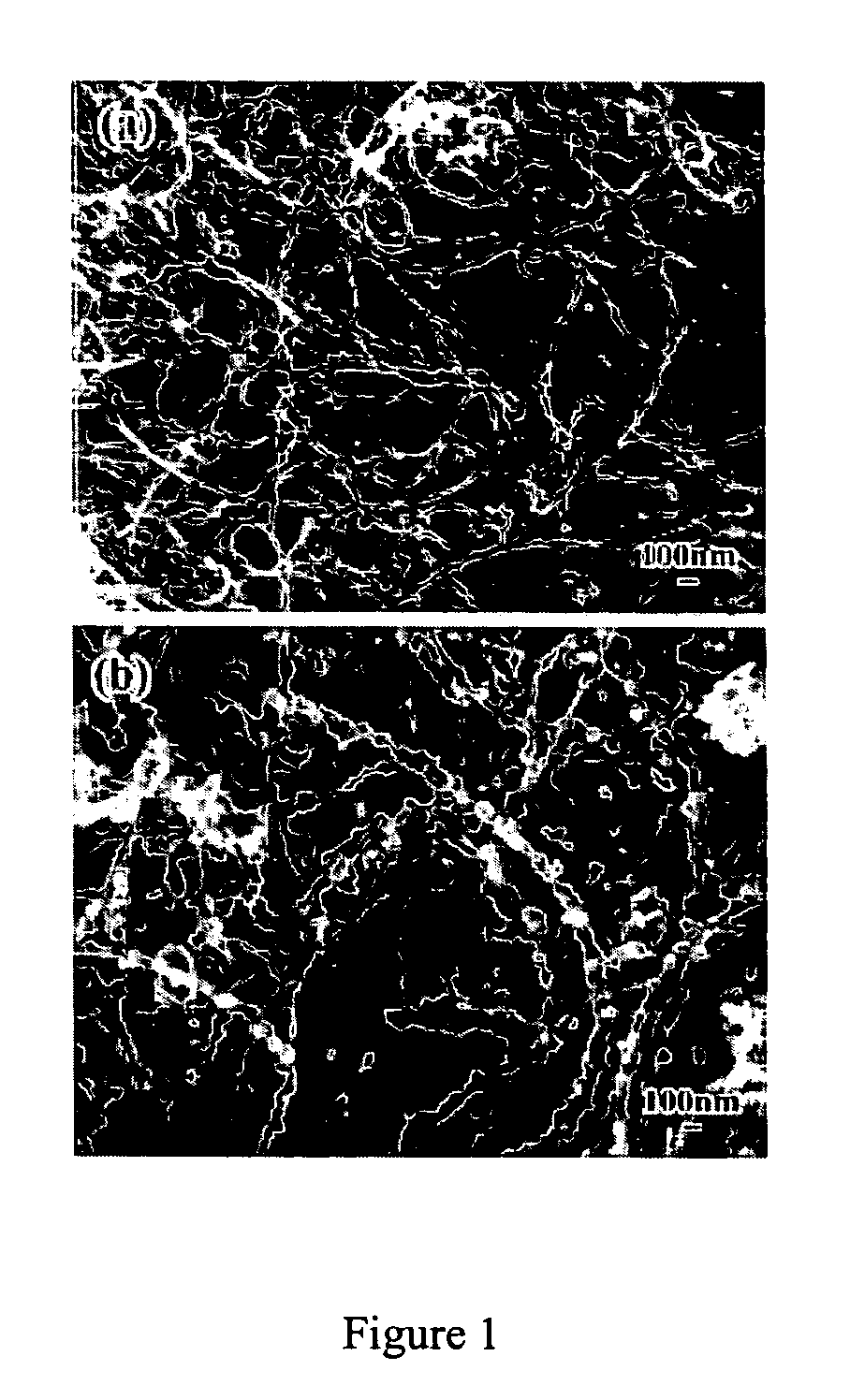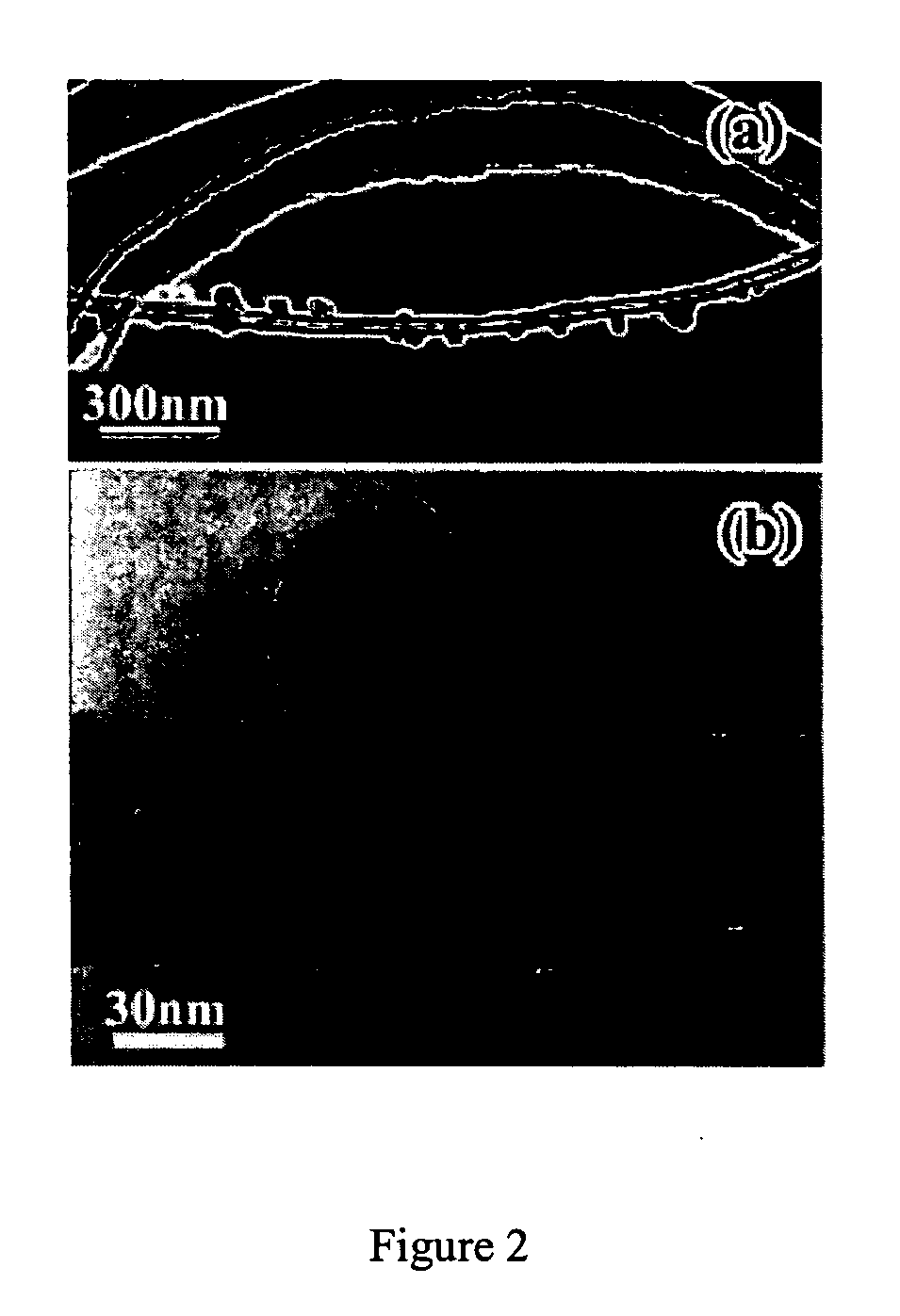Reinforced carbon nanotubes
a carbon nanotube and reinforced carbon technology, applied in chemical vapor deposition coating, inorganic chemistry, textiles and papermaking, etc., can solve the problems of reduced load bearing ability, failure mechanism of “sword-in-sheath” type, and no significant improvement in mechanical properties after such modification, and achieve high strength and improved mechanical properties.
- Summary
- Abstract
- Description
- Claims
- Application Information
AI Technical Summary
Benefits of technology
Problems solved by technology
Method used
Image
Examples
example 1
Synthesis of Reinforced CNTs Having Boron Carbide (BxCy) Nanolumps Formed Substantially on the Surface of the CNTs
[0067] The multi-wall CNTs were grown by catalytic chemical vapor deposition method (see Li, et al., Appl. Phys. A: Mater. Sci. Process, 73, 259 (2001), the contents of which is incorporated herein by reference in its entirety) and purified by hydrofluoric acid (HF). Magnesium diboride (MgB2), a new superconducting material, is used as the source of boron. The synthesis of magnesium diboride (MgB2) can be synthesised by combining elemental magnesium and boron in a sealed (Ta) tube in a stoichiometric ratio and sealed in a quartz ampule, placed in a box furnace at a temperature of about 950° C. for about 2 hours. Powder MgB2 with average grain size of about 1 micrometer decomposes at a temperature of about 600° C. Thermally decomposed boron is more chemically reactive so the solid-state reaction can be performed at relatively low temperatures. The nanotubes were mixed g...
example 2
Determining the Composition of BxCy Nanolumps
[0068] In order to find out whether the nanolumps are boron carbide, a high-resolution transmission electron microscopic (HRTEM) image of a nanolump is taken and shown in FIG. 3(a). The carbon nanotube nature has been preserved after the reaction. The BxCy nanolump is crystalline. FIG. 3(b) is an enlarged HRTEM image of the top part of FIG. 3(a). FIG. 3(c) shows a fast-Fourier transformation (FFT) image of the HRTEM image shown in FIG. 3(b). The diffraction pattern obtained from FFT (FIG. 3(c)) is indexed as one from zone axis ({overscore (1)}11) of B4C. Structure parameters of B4C for the indexing are space group R3m: (166) and lattice parameters, a=0.56 nm, c=1.21 nm. As shown in FIG. 3(b), the simulated HRTEM image using parameters defocus −30 nm and thickness 20 nm also matches with experimental image very well. Although no boron was detected by the EDS analysis, it is reasonable to draw a conclusion that the nanolumps are of the fo...
example 3
Preparation of Catalyst Substrate for Synthesis of Linear CNTs
[0069] Mesoporous silica containing iron nanoparticles were prepared by a sol-gel process by hydrolysis of tetraethoxysilane (TEOS) in the presence of iron nitrate in aqueous solution following the method described by Li et al. (Science, (1996), Vol. 274, 1701-3) with the following modification. The catalyst gel was dried to remove excess water and solvents and calcined for about 10 hours at about 450° C. and about 10−2 torr to give a silica network with substantially uniform pores containing iron oxide nanoparticles that are distributed within. The catalyst gel is then ground into a fine, micro-particulate powder either mechanically using a ball mill or manually with a pestle and mortar. The ground catalyst particles provide particle sizes that range between about 0.1 μm and about 100 μm under the grinding conditions.
PUM
| Property | Measurement | Unit |
|---|---|---|
| pressure | aaaaa | aaaaa |
| temperature | aaaaa | aaaaa |
| diameter | aaaaa | aaaaa |
Abstract
Description
Claims
Application Information
 Login to View More
Login to View More - R&D
- Intellectual Property
- Life Sciences
- Materials
- Tech Scout
- Unparalleled Data Quality
- Higher Quality Content
- 60% Fewer Hallucinations
Browse by: Latest US Patents, China's latest patents, Technical Efficacy Thesaurus, Application Domain, Technology Topic, Popular Technical Reports.
© 2025 PatSnap. All rights reserved.Legal|Privacy policy|Modern Slavery Act Transparency Statement|Sitemap|About US| Contact US: help@patsnap.com



